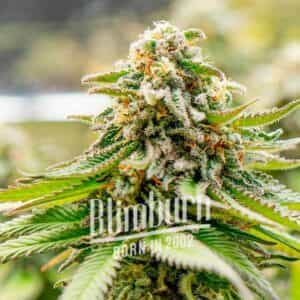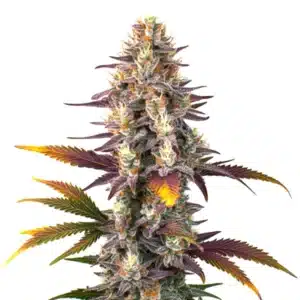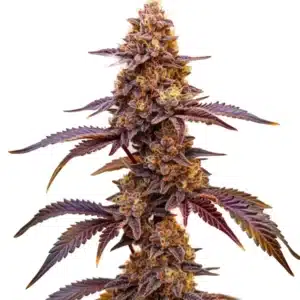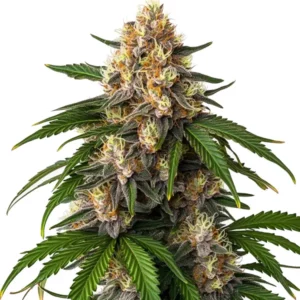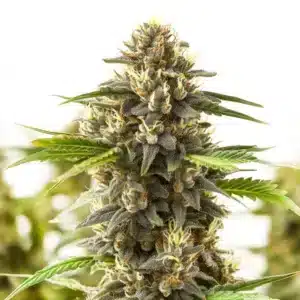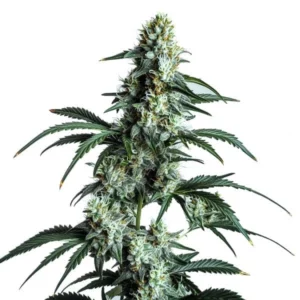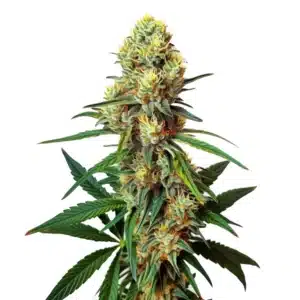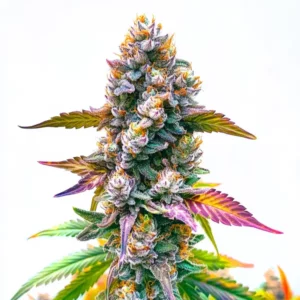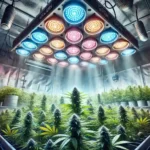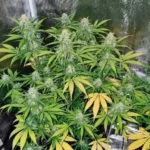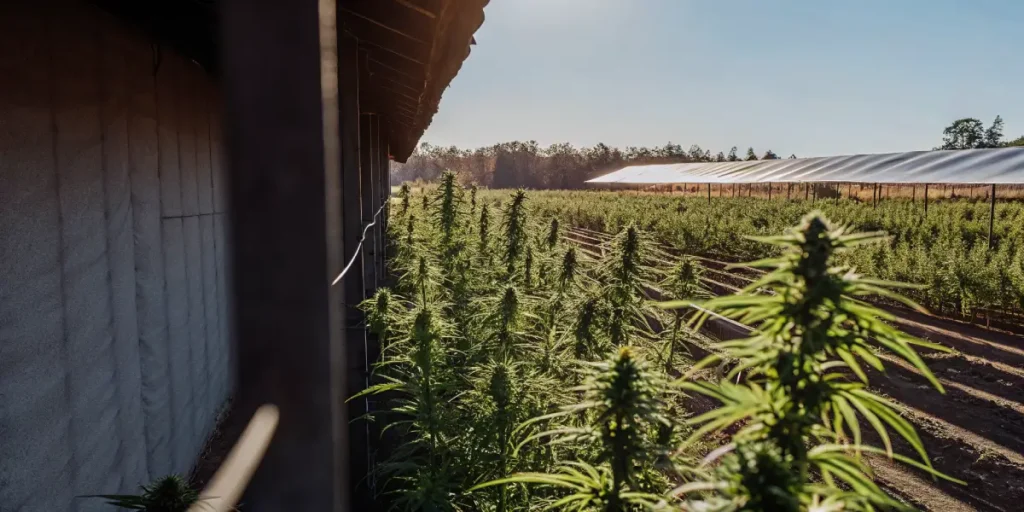
How Light Affects THC and Terpene Production
Light is crucial for cannabis plants, acting as their energy source. How light affects THC and terpene production can change the quality of your harvest. Both first-time cannabis seed buyers and seasoned growers need to consider this factor for optimal results.
Every cannabis strain reacts differently to light. Some, like the Gorilla Glue 4 x Zkittlez, thrive under strong lights, producing higher THC levels. Others might focus on boosting terpene production under similar conditions.
Recommended Strains
Blue Dream
|
|
THC | 17% - 24% (Medium) |
|
|
Type | Feminized |
|
|
Yield | High |
|
|
Phenotype | 50% Indica / 50% Sativa |
GG4 x Z OG
|
|
THC | 20% - 24% (Medium) |
|
|
Type | Feminized |
|
|
Yield | High |
|
|
Phenotype | 60% Indica / 40% Sativa |
Lighting can make or break your growing efforts. The effects of light spectrum on THC levels are profound and direct. By choosing the right light setup, you can maximize your plant’s potential, ensuring a rich cannabinoid and terpene profile.
Effects of Light Spectrum on THC Levels
The color of light, known as the light spectrum, plays a pivotal role in cannabis growth. Blue light encourages bushy plant growth and is essential during the vegetative stage. This stage is crucial for setting up a strong plant structure, which later supports the buds.
When it comes to THC levels, red light becomes more significant. During the flowering stage, red light promotes bud development and increases THC potency. Strains like Blue Dream are known to respond well to this spectrum, producing buds rich in cannabinoids.
Knowing how light affects THC and terpene production is essential for achieving the desired potency and flavor. By manipulating the light spectrum, growers can enhance the natural attributes of the cannabis plant, aligning their growing techniques with the plant’s genetic potential. The right spectrum can lead to robust plants with a balanced cannabinoid profile, optimizing the effects of light spectrum on THC levels.
While red and blue lights are vital at different stages, full-spectrum lighting can provide a well-rounded growth environment. This allows for a seamless transition from vegetative to flowering stages, supporting the plant’s health throughout its life cycle. Using full-spectrum lights, growers can ensure that their cannabis plants receive a balanced exposure, which is crucial for maximizing both THC and terpene production.
- Blue light: Best for vegetative growth
- Red light: Enhances flowering and THC production
- Full-spectrum: Balances growth and flowering stages
How UV Light Influences Terpene Synthesis
UV light, often overlooked, significantly impacts terpene synthesis. This part of the spectrum isn’t visible to the naked eye but is crucial for certain chemical reactions in plants. UV light can lead to an increase in terpene production, giving cannabis its distinctive aroma.
Terpenes not only affect the smell but also the flavor and effects of cannabis. For instance, the Sour Diesel strain benefits from UV exposure, enhancing its pungent, diesel-like aroma. Growers can strategically use UV light to elevate the terpene profile of their plants.
The function of UV light in cannabis cultivation extends beyond just terpene synthesis. It can also influence the plant’s overall resilience, increasing its resistance to pests and environmental stressors. By learning how UV light influences terpene synthesis, growers can create more robust plants that thrive in various conditions.
However, knowing the balance is key. While UV light can boost the plant’s aromatic profile, excessive exposure can be detrimental. It’s crucial to tailor the UV levels to the specific strain and growth stage, ensuring that the plant benefits from increased terpene production without suffering from stress or damage.
However, caution is necessary. Too much UV light can stress plants, leading to damage rather than improvement. Balancing UV exposure is key for healthy, terpene-rich buds.
Promos & Deals
Optimal Light Conditions for Cannabis Terpene Production
Terpenes are volatile compounds that give cannabis its unique flavor and aroma. The optimal light conditions for cannabis terpene production involve a mix of blue and red light, with occasional UV exposure. This combination encourages plants to develop complex terpene profiles and also illustrates How Light Affects THC and Terpene Production, showing the direct link between lighting strategies, potency, and aroma.
By adjusting your light setup, you can influence the type and amount of terpenes produced. For example, increasing blue light can enhance citrus-like terpenes, adding a fresh note to your cannabis strain.
Creating optimal light conditions for cannabis terpene production requires an knowing of the plant’s lifecycle and its specific needs. Each stage of growth demands different light intensities and spectrums, which can significantly impact the plant’s aromatic and flavor profile. By experimenting with various light setups, growers can coax out unique terpene expressions that define their cannabis strains.
Additionally, integrating technology such as adjustable LED systems can provide growers with the precision needed to fine-tune light conditions. This level of control ensures that the plants receive the exact energy inputs necessary for developing rich and diverse terpene profiles, ultimately enhancing the quality and uniqueness of the final product.
- Balanced spectrum: Promotes diverse terpene profiles
- Controlled UV exposure: Enhances specific terpenes
- Adjustable light setups: Allow for precision growing
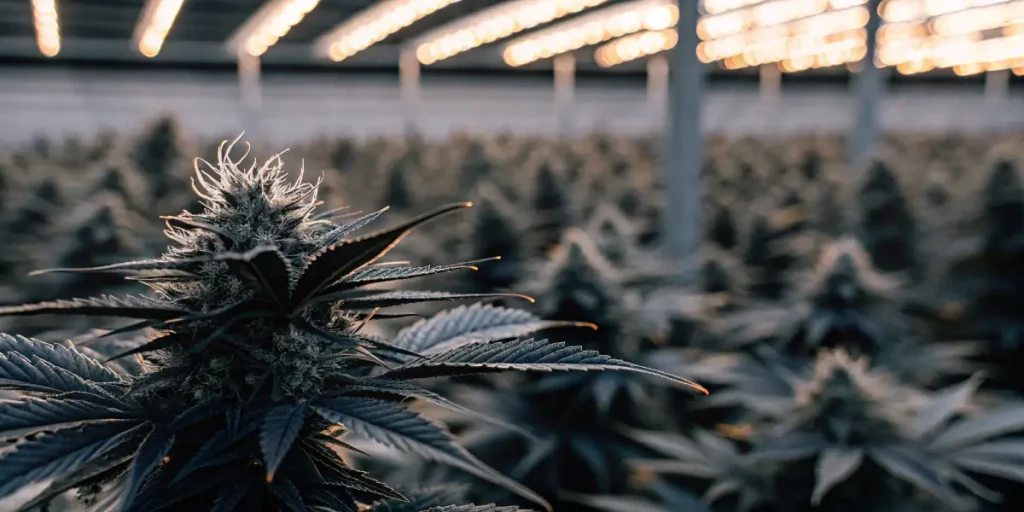
Role of Light Intensity in THC Development
Light intensity is another critical factor in THC development. More intense light means more energy for the plant, potentially leading to higher THC levels. However, finding the right balance is crucial as too much light can harm the plant.
Strains like CBD Critical Mass benefit from higher light intensity, resulting in dense, THC-rich buds. These plants need to be monitored closely to prevent light burn, which can damage the leaves and reduce yield.
The role of light intensity in THC development is pivotal for maximizing yield and potency. By carefully monitoring and adjusting light intensity, growers can create an optimal environment that encourages the production of THC-rich buds. It’s important to gradually acclimate plants to increased light levels to prevent shock and potential damage.
Advanced lighting solutions, such as dimmable LEDs, offer the flexibility to control light intensity according to the plant’s growth stage. This not only enhances THC development but also contributes to the overall health and robustness of the cannabis plant. Proper management of light intensity can distinguish between a mediocre and a superior harvest.
Adjusting light intensity can be as simple as moving the light source closer or further away. Growers should observe their plants and adjust accordingly to ensure they receive the perfect amount of light.
Impact of Photoperiod on Cannabinoid and Terpene Profiles
The photoperiod, or the amount of light and darkness a plant receives, influences its growth stages. During the vegetative stage, cannabis plants need more light, usually 18 hours a day. This extended light period supports robust growth and prepares the plant for flowering.
Switching to a 12/12 light/dark cycle triggers the plant to flower. This change in photoperiod affects cannabinoid and terpene profiles, as the plant focuses energy on bud production. Adjusting the photoperiod can, therefore, manipulate the plant’s chemical makeup.
Knowing the impact of photoperiod on cannabinoid and terpene profiles allows growers to fine-tune the timing of light exposure to achieve specific results. By manipulating the light cycle, growers can influence the plant’s internal processes, leading to enhanced production of desired compounds.
Beyond just triggering flowering, the photoperiod can also impact the speed and quality of bud development. By customizing the light cycle to align with the plant’s natural rhythms, growers can optimize both the yield and the chemical profile of their cannabis crops, achieving a tailored growing experience that meets their specific goals.
- 18/6 cycle: Best for vegetative growth
- 12/12 cycle: Initiates flowering
- Customized cycles: Tailor plant development

FAQs
What is the best light spectrum for THC production?
Red light is generally considered the best for THC production, especially during the flowering stage. It encourages bud development and increases the potency of cannabinoids. Many growers use full-spectrum lights that incorporate both red and blue spectrums to optimize growth from seedling to harvest.
Using a combination of lights, including UV, can further enhance the plant’s chemical profile. Strains like Gorilla Glue 4 x Zkittlez respond well to these conditions, producing high levels of THC. It’s important to monitor the plant’s reaction and adjust the light as necessary.
Exploring how light affects THC and terpene production can lead to deeper insights into optimizing growing conditions. Each strain may respond differently to light spectrums, requiring a tailored approach to achieve the best results.
By incorporating advanced lighting strategies and experimenting with different spectrums, growers can discover the ideal conditions for maximizing THC production. This nuanced knowing of light’s effects on cannabis can lead to more potent and flavorful harvests, elevating the overall quality of the plant.
How does UV light affect terpenes in cannabis?
UV light plays a crucial role in boosting terpene synthesis. It triggers the plant’s defense mechanisms, leading to an increase in terpene production. This results in cannabis with a stronger aroma and flavor profile, enhancing the overall experience.
However, growers must balance UV exposure. Excessive UV can damage plants, leading to lower yields. Strains like Sour Diesel can benefit from controlled UV exposure, resulting in a richer terpene profile without harming the plant.
By knowing how UV light influences terpene synthesis, growers can strategically use it to enhance their cannabis strains’ aromatic and flavor profiles. This approach requires careful management of UV levels to prevent potential stress and damage to the plants.
Balancing UV exposure with other light spectrums can create a harmonious environment that supports terpene production without compromising plant health. This delicate balance is key to cultivating cannabis with complex and appealing terpene profiles.
Why is light intensity important for cannabis growth?
Light intensity directly affects the energy available to the plant. Higher intensity means more energy for growth and development, leading to potentially higher THC levels. However, too much light can cause stress and damage, reducing overall yield.
Strains such as CBD Critical Mass thrive under higher light intensity, producing dense, potent buds. Monitoring and adjusting the light intensity is crucial to prevent plant stress and maximize yield.
Knowing the function of light intensity in THC development is essential for achieving optimal growth conditions. By carefully calibrating light levels, growers can create an environment that supports vigorous plant development and enhances cannabinoid production.
Advanced lighting solutions, such as dimmable systems, offer the flexibility to adjust light intensity throughout the plant’s growth stages. This adaptability ensures that cannabis plants receive the right amount of energy at each stage, maximizing both yield and quality.
What are the optimal light conditions for terpene production?
Optimal light conditions for terpene production involve a balanced spectrum of blue and red light, with occasional UV exposure. This setup encourages plants to develop diverse and complex terpene profiles, enhancing the plant’s aroma and flavor.
Adjusting the light spectrum can influence the specific terpenes produced. For instance, increasing blue light can enhance citrus-like terpenes. Tailoring the light conditions to your strain’s needs can significantly impact the quality of the final product.
Experimenting with different light setups can reveal the best conditions for maximizing terpene production in specific cannabis strains. This exploratory approach can lead to unique flavor and aroma profiles that distinguish your cannabis from others.
By knowing the optimal light conditions for cannabis terpene production, growers can create a customized environment that encourages the expression of desired terpenes. This level of control over plant development is key to producing high-quality, aromatic cannabis.
How does the photoperiod impact cannabis growth?
The photoperiod, or the light/dark cycle, is crucial for cannabis development. During the vegetative stage, longer light periods encourage growth. In contrast, a 12/12 cycle triggers flowering, focusing energy on bud production.
Manipulating the photoperiod can influence both cannabinoid and terpene profiles. This allows growers to tailor their plants to produce desired effects and flavors, providing a customized growing experience.
Exploring the impact of photoperiod on cannabinoid and terpene profiles is essential for knowing how light affects THC and terpene production. By adjusting the light/dark cycle, growers can influence plant development, achieving a balance between growth and flowering stages.
Customizing the photoperiod to align with specific growth objectives can lead to enhanced cannabinoid and terpene production. This level of control over the plant’s biological processes enables growers to cultivate cannabis that meets their precise quality and potency goals.



